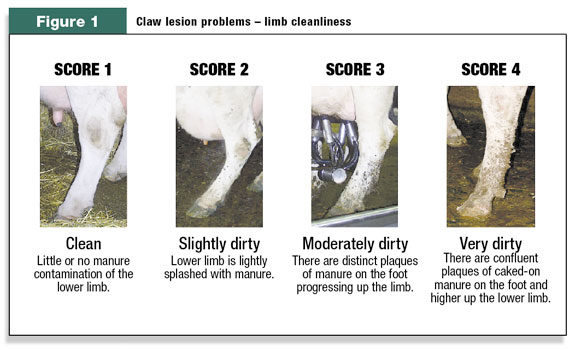The onset of cold, wet winter weather can present a unique set of challenges when it comes to managing infectious lesions that cause lameness on a dairy. “While many dairies use footbath programs throughout the year to help control infectious lesions, use typically decreases during winter months due to the potential for ice formation and the fact that some footbath products, such as formaldehyde, are ineffective in cold conditions,” says Dr. Jeff DeFrain, research nutritionist, Zinpro Corporation. “The result is that the typical weather conditions can lead to a breakdown in skin integrity, allowing easy entry of bacteria into the foot.”
Research has shown that on most dairies in northern climates, the percentage of cows treated for infectious lesions such as digital dermatitis (hairy heel warts) and foot rot increases during the winter months.
Infectious lesions can be caused by a variety of factors, including inadequate footbath programs, dirty environmental conditions, stress, introducing cattle from an infected herd, lack of claw maintenance programs and inadequate nutrition (micronutrients).
“To determine if infectious lesions are a problem in the herd, we advise producers to review their hoof-trimming records,” DeFrain notes. “By comparing the incidence of infectious lesions versus non-infectious lesions, the primary cause of lameness can be identified.”

If infectious lesions are found to be a problem during the winter months, Dr. DeFrain offers the following management strategies:
1. Practice good biosecurity procedures. All newly-arrived cattle should go through a footbath several times.
2. Focus on keeping cows cleaner. Pay attention to the frequency of pen/stall cleaning, role of automatic alley scrapers, stocking density, barn layout, and manure management, walkways and alleyways.
3. Improve effectiveness of footbath program ( see "Winter footbath management considerations" below ).
4. Use cow leg hygiene scores ( see Figure 1, above right ) to help determine appropriate frequency of footbath use ( see Table 1, above left ).
5. Maintain a good micronutrient program. Trace mineral nutrition plays a critical role in building and maintaining strong, healthy feet.
6. Maintenance trim cows at least two times per year. Trimming helps keep cows off their heels, while also opening up the interdigital space. PD
— Excerpts from Zinpro news release
Winter footbath management considerations
• Ensure cows have access to a clean area after passing through a footbath.
• Stop using formaldehyde when temperature of solution cannot be maintained above 45 degrees Fahrenheit.
• 5 percent copper or zinc sulfate solutions
• Use hoof-trimming records to determine efficacy of alternative commercial products.
• Change footbath treatment solution every 150 to 200 cows. This frequency will vary depending on cow cleanliness, use of a pre-bath, type of disinfectant or chemical concentration, biosecurity, level of infectious claw lesions in the herd, and weather conditions.
• Thoroughly drain footbath and rinse before mixing a new batch of solution.
• On days when footbaths are not filled with a treatment solution, consider filling the pre-bath (if used) and treatment bath with a 1 percent mild soap solution. This can help minimize manure buildup on feet.
Additionally, if icing around the footbath is a problem, consider the following:
• Add salt or glycerin (glycerol) to footbaths, which helps reduce freezing point of solution
• Have heated floors around the footbath
• Set up temporary footbaths in heated areas during icing periods
• Go to a spray program when footbaths cannot be used





